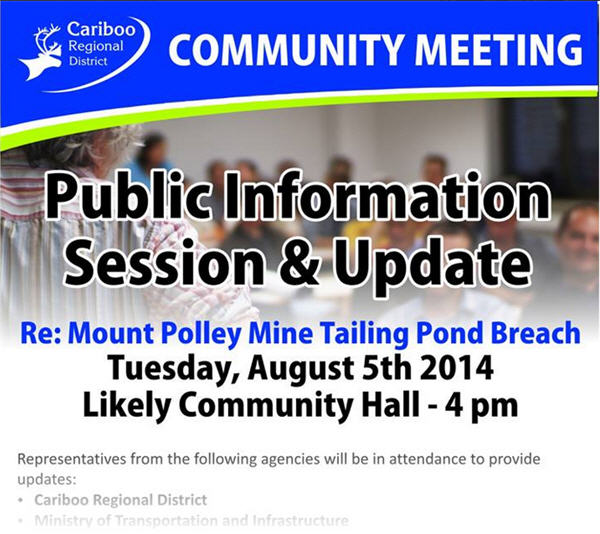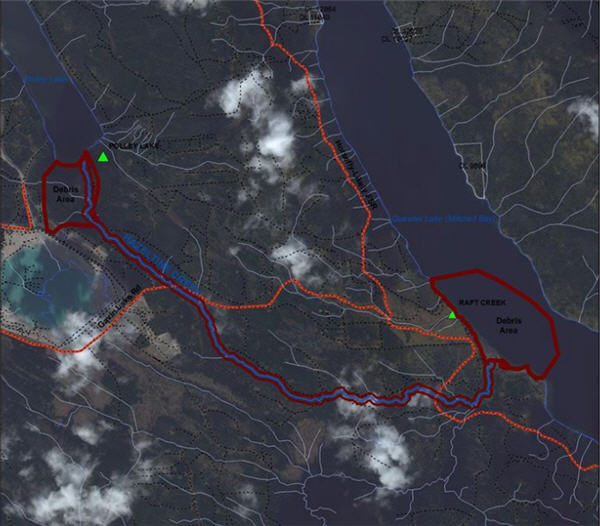What caused the Mount Polley tailings pond failure?
It is always a very sad day when a major tailings facility failure occurs. As one commenter noted to me: “Whatever the facts, the failure casts a poor light on the industry, and makes all of our jobs more difficult in the future.”
Today we write about the failure of the Mt Polley tailings facility right here in British Columbia. I write only on the basis of the information readily available on the web. I have no other source of knowledge of this facility.
My first impression is that this is in a direct line of failures from Bafokeng, through Merriespruit, to now. Nothing has changed, this failure looks just like the failed Bafokeng dam looked when I went out to see it the week after it failed way back in the earlier 1970s.
We still cannot agree if the cause of the Bafokeng failure was overtopping of the crest of the perimeter embankment by too much water in the dam, piping of water through a sandy layer in the embankment, or slope instability via sliding of soft foundation clays.
The pictures I see, leave me wondering if the failure at Mt Polley was overtopping, piping, or basal failure. As at Bafokeng, I suspect it was all three in a perfect triad of a storm. We will probably never know for sure as the evidence is washed away to the lake or strewn on the ground downstream of the failed facility. Thus some still claim that at Bafokeng the bulldozer sent to raise the embankment induced liquefaction of the wet tailings. Can’t help but notice the stranded bulldozer at Mt Polley—had it gone up there to raise the embankment?
Maybe the driver of the bulldozer we see perched on the edge of the failure zone saw something. If he did, you can be sure he is safely under wrap and key at this time.
Was the mine aware that something might happen? Some early reports I read which I cannot now find, say that there was a “breach” last year. Some reports talk of a Vancouver environmental company recommending more monitoring. One person I chatted to said they had heard that a young student had spent the summer doing QA/QC work on construction at the dam. Some reports say that the engineers of record are at the site, but their name is not given.

Poster for public information session held by the Cariboo Regional District.
I cannot work out how to access the files of the relevant BC authorities so as to get a look at any dam safety reports that may have been submitted in the past—do such sites exist in BC. They do in many other jurisdictions. If there is no such site, maybe the BC authorities can release such files at this time to enable the profession to learn from what happened.
Many are asking about the chemicals in the materials released. While not a trivial issue, it seems to me that the bigger issue is the apparently large quantities of tailings that are now settled downstream and are probably sedimenting in the lake. It is going to take a lot of work to clean up the solids.
At Bafokeng, soon after the failure, the mining company went in and closed the breach and started tailings deposition soon after–you have to keep the mine running afterall. I cannot conceive how today, that will be allowed, but clearly the breach has to be closed up soon, for there are still lots of tailings waiting to be eroded once the rains start.
I do not know if the mine has a second tailings facility–probably not, so for now the mine is down. And so too I suspect are plans for opening new mines by Imperial Metals.
At this link, is a picture showing the tailings facility full of water. That is just how Bafokeng was the day it failed. In one of those earlier reports I read that the mine had been negotiating with local tribes to release water, but the tribes would have none of it. Pity for now all is released. But then the mine should have been insistent, for holding as much water on the dam as the link picture shows is bad practice as we know from Bafokeng and Merrispruit.
It is difficult to tell from the pictures how high and how steep the perimeter embankment is. But to judge by the size of the bulldozer in one picture I guess about thirty to fifty meters high and about two horizontal to one vertical. It is difficult to tell what the embankment is constructed of. Looks pretty blocky in some pictures, but surely this was not all borrow material. Did they use some cyclone underflow sand?
The current situation is best summed up in the report:
A UNBC Environmental Sciences professor is on his way to the site of Monday’s breach of the Mount Polley mine.
Phil Owens says he is joining a team of researchers to examine the damage the mine’s breach had on the local water-ways. “We’ve been taking samples already, since we heard about this,” he says. “We’re looking at the impact and are looking at the impact and how we might be able to help the local communities and mine staff to alleviate the problem and understand the long-term impacts.” He says a catastrophic like this is very rare and no one knows yet what the full impacts are.
– See more at: http://hqprincegeorge.com/unbc-prof-headed-to-mt-polley-disaster-site/#sthash.e8iReq9K.dpuf
No doubt other academics are on their way too. We need more than professors of environment looking at water quality impact, important as that is. We need engineers, operators, systems analysts, and regulators to tell use how this came to be, and why the many lessons of the past were blatantly ignored at this mine. For this is a disaster. It is not that rare. It has happened before. The industry knows how to prevent this. But once again the system has failed. And this time the implications for the companies involved will be dire.

Map showing flow of debris and slurry after tailings pond breach. Image from Cariboo Regional District.
More News
{{ commodity.name }}
{{ post.title }}
{{ post.date }}




7 Comments
Nat C
Jack, does this report shed any engineering light on the flaws behind such a system?
http://www.imperialmetals.com/i/pdf/43-101_MtPolley.pdf
applepear
Maybe you look at the history. 5 years ago Imperial asked for a discharge permit for treated water from the dam. The water was completely benign, and was approved by the government. The native community rejected the release of any water. so now this is what you get. What was the company to do when rains filled the dam?
djfanon
The indications seem to be that this was the only tailing facility present at the mine. Unless you are suggesting that the mining company had ceased operations (ie. the creation and storage of tailings in this facility), and this disaster is to be blamed on rains I hardly see the relevance of that comment.
The fact is containing that volume of tailings in tall earthen dam is simply unwise. The article author brings up several similar failures which were not enough to amend this bad practice in the mining industry. Better hope this water is as benign as Imperial says (From the looks of the on-site video I am skeptical… time will tell).
Smella Badd
Another example of deregulation and corruption,just our Government keeping our best interests up front. as usual. If it is found that Imperial mine had any idea that there was a problem,it should be criminally charged+ heavily fined………..
Rodney
I posted a note on another web site reporting on this incident, which I copy below. Having been in the mining business for many years, one thing that disturbs me greatly is that the decision making for many of the mine site activities is called by bean-counters, instead of by engineers, or managers formerly responsible for engineering matters at operating mines.
Perhaps there is something to be said about the denial of requests for releases from the tailings dam by treated waters…. I suspect the deniers were not engineers….
Silt happens! As a mining and minerals exploration person for +40 years, and an avid hunter and fisherman who loves to take family and friends into the natural environment, these events hurt me to the very core of my being.
It is important to remember, and for those who are not geologists – to consider, that the present surface of the earth is but a current manifestation of what used to be there. The surface of Earth is being eroded at an average rate of less than two-hundredths of a millimeter per year. So, an observant person might recognize that in one hundred years of life, two millimeters of land around them has been eroded from the hills and mountains and passed through those beautiful creeks to the ocean.
Over the past one million years, 20,000 millimeters, or 20 meters of land have gone to the ocean. Over 20 million years, a mere 400 meters of the land surface (1,312 feet or a quarter of a mile) has been transported through those very same pristine creeks and rivers to the ocean. When you consider that the rocks exposed at the surface in the area of the incident are more than 60 million years old, it helps to put things into perspective.
Notwithstanding, the persons responsible for this incident should be held accountable for the near-term damage done….
Derek
why not dry stacking?
minedoubt
causes could be related to negligence in design, contruction, or operation. But at this preliminary stage i would say that the fundamental cause to bring to light is the systemic issues in the mining industry today. the professionals who work at mines are focused on getting the material out of the ground, and processing it to a sellable product. Downstream issues related to tailings “geotechnical engineering” are 99% of the time sourced to external consultants. This is ok in theory, but in practice, the devil becomes lost in the details. A consultant can “say” the correct things in a report, but he can’t make a decision maker “do” it. Moreover – with all the cost squeezing being brought into the system at the corporate level (we can also thank bay st/wall st for this pressure) – the downstream issues are likely to be put at the bottom of the priority pile, and/or green consultants are brought-in because they have a cheap charge rate.
Bottom line – 1) designers/consultants need to make sound, clear and practical recommendations also putting in-place mechanisms for followup, 2) mine managers need to respect these recommendations and prioritize the work, 3) corporate managers need to allocate financial resources accordingly, 4) government institutions need to provide diligent auditing / governance to validate the system is working correctly.